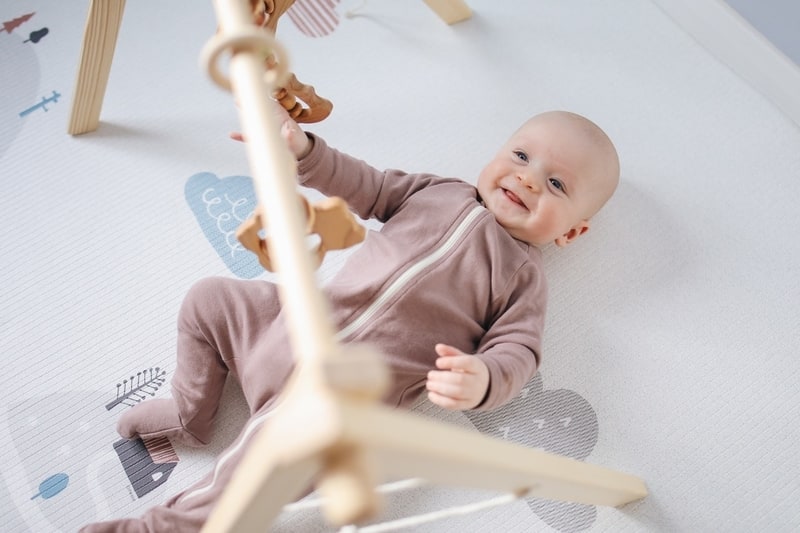Every parent knows that the initial days with the newborn baby are both challenging and exciting. Your baby cries all the time and you have no idea that why he’s crying. Luckily some experts have decoded these unique baby languages and I’m going to share some signs to figure it out what your bundle of joy is trying to say.
1. Baby Cry

Let’s start with the way your baby cries. During the first four months of life, crying is the main way babies express their needs. Here are 7 types of cries to listen for and understand what they mean actually.
- A Calling Cry
Whenever you hear that your baby is crying for 5 to 6 seconds and then pauses for the next 20 seconds, that’s a calling cry. This means that your baby has been alone for a while and now desperately needs your attention. If you don’t respond right away, you’ll hear a fascinating cycle of cry a couple of more times. So pick your baby up and give them all the love they need.
- A Hunger Cry
This type of cry is very similar to the calling cry with one little camp. If you don’t get in there right away, the crying becomes hysterical quickly. Your baby may start rotating their head and can make smacking sounds with their mouth. This is just a clear sign that it’s time to feed.
- A Pain cry
If you hear a pain cry once, you’ll never confuse it with any of the others. This crying is flat and constant. This type of crying is also very loud unless your baby is not really strong enough to make loud noises.
- A Physiological Cry
A baby deals with all kinds of functions from having gas and constipation etc. Newborn usually lets you know right away by veining and squeaking as they cry.
- A Sleep Cry
Sleep is another problem for new born babies. Sometimes they just can’t sleep. I can relate “I slept like a baby”. Their cry sounded like smooth and veining follows by load of yawning. Sleepy babies also rub their eyes and ears.
- A Discomfort Cry
This cry sounds very irritating. Your baby can also move their arms, legs and their backs. This usually means that it’s time to check their diapers or change their clothes. They may be either too hard or too cold.
- A Bored Cry
This one is extremely calm. Your baby cries constantly and you can’t figure it out that why your baby is crying. You try to do everything you can. Don’t worry and stay calm. Your baby is simply frustrated or bored. Take her for a walk outside around the house. If you have twins, bringing them out on a double stroller ride may help to cheer them up. A simple environment change can stop the cry.
You got the different cry scenarios of your baby.
2. Baby Sounds

Now I’m going to let you know about the other sounds your baby makes. All these strange sounds like “Neh”, “Eh”, “Eairh”, “Heh”, “Oh” have proper meaning. Australian doctor, Dr. Priscilla Dunsten has been studying all these childhood sounds for more than 20 years. She examines 3 to 4 month old babies of different nationalities during her research. According to Dunsten, your new born baby starts actively making communication sounds after only 4 months old. Before that the sounds are just primary reflex that needs to be figured out.
Here’s a little sound cheat sheet:
- “Neh”
It indicates I’m hungry here. Feed me! This sound comes from your baby pushing their tongue up to refill their mouth triggering the sucking reflex.
- “Eh”
It indicates that your baby want to burp now! Your baby tries to release it from the mouth.
- “Owh”
It indicates I’m so sleepy and tired. Your baby just folds their lips for yawing and this sound just comes out.
- “Heh”
It indicates your baby is uncomfortable and not feeling good. The baby can give away their feelings by constantly moving and jerking their hands during feed as well.
- “Eairh”
It indicates “I’ve a sour tummy mommy, help!” this strange sound can turn into a moan. Your baby stretches the belly and exhales. Don’t ignore the symptoms and make an action right away.
That’s basically all the baby sounds that you need to know.
3. Baby Movements

I’ve one more important lesson for your newborn baby movements. Small babies have their own body language. They can help you to detect their needs and moods.
- Arching their backs
Parents know that babies under 2 months old arch their backs. In most cases, it’s just a typical response to pain. But there are couple of exceptions for this. If your baby arches their back during eating, it’s a sign of reflex. After eating it means they are full. Sometimes babies arches their back because they are simply tired or in a bad mood.
- Rotating their head
This is your baby’s way of calming down. You usually see this when your baby is about to fall asleep or hang out with people they don’t know yet. Good thing is you can help your baby by gently rubbing their back and they will instantly relax.
- Grabbing their ears
This may look pretty scary but it’s completely natural. Your baby is simply exploring your body. However ear rubbing is followed by intense crying, you should visit the doctor.
- Clenching their fists
Fist or no fist shows how much hungry your baby is. A perfectly relaxed hand means that they are full. While strong fist shows that they need baby food quickly. Noticing this little detail in time can help you prevent the hungry crying and saves your time and you from stress.
- Lifting their legs
During the first months of your newborn baby’s life, colic and tummy pain are almost inevitable. Your baby tries to cope with it on their own by lifting their legs to ease those unpleasant sensations, but any additional help from you is totally welcome. Tummy rubs are awesome.
- Jerking their arms
Loud sounds, bright lights, and sunlight evoke the startle reflex in little babies. As a result, they jerk their arms without any fear. In this case, your job is to comfort your baby and make sure that they feel alright.
That’s everything you need to know to read your baby’s mind. Parents need to talk to their babies as often as possible. Parents should show the things around them and tell cool stories even if you feel like that they don’t understand you. This communication will help them to develop their own communication sounds and gestures to express their needs better.
Read Also: Potty Training Chart: A Complete Guide for Potty Training Boys and Girls














it’s a worth reading blog. great effort dania waheed you have done a great job. all mothers n women should read this